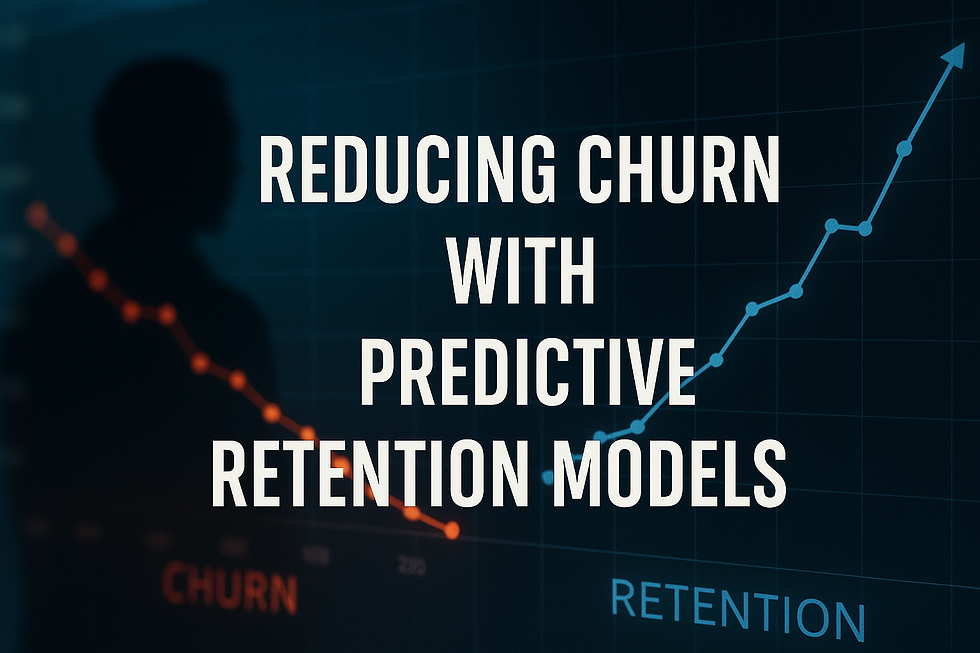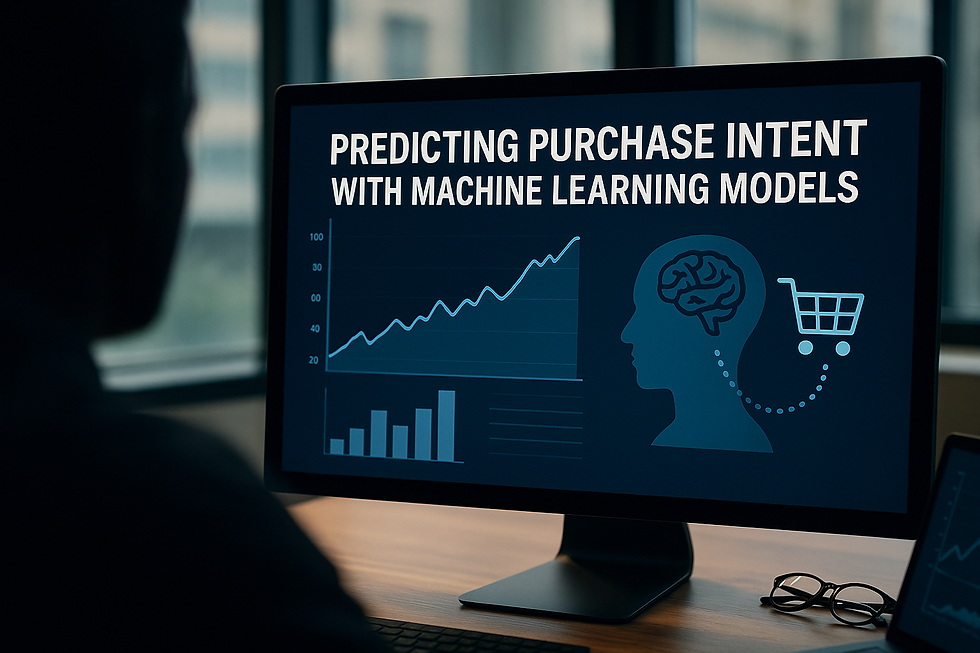Machine Learning for Customer Churn Prevention in Sales
- Muiz As-Siddeeqi

- Aug 27
- 6 min read

Machine Learning for Customer Churn Prevention in Sales
They came.
They clicked.
They even bought once or twice.
But now… silence. No replies. No repeat purchases. No engagement.
And before your team even realizes what's happened, another loyal customer has slipped quietly out the back door.
This is the heartbreak of churn. And it’s not just sad—it’s expensive. According to Harvard Business Review, acquiring a new customer can cost 5 to 25 times more than keeping an existing one. Yet most sales teams spend their energy chasing shiny new leads—while neglecting the very people already in their pipeline.
But what if you didn’t have to wait until it was too late?
What if you could see churn coming before it even knocked?
What if you had a system that could whisper, “This one’s about to leave. Save them.”?
That’s not science fiction. That’s exactly what machine learning customer churn prevention is built to do.
In this blog, we’re going deep into one of the most emotionally overlooked, financially devastating, yet massively fixable problems in modern sales—and how real, verifiable machine learning strategies are helping real businesses stop the churn before it happens.
Bonus: Machine Learning in Sales: The Ultimate Guide to Transforming Revenue with Real-Time Intelligence
Churn Is the Silent Killer of Sales Revenue
Churn is quiet. It doesn’t announce itself. It creeps in through disengagement, unmet expectations, unresolved complaints, and forgotten follow-ups.
And it’s deadly. Here’s why:
According to a 2023 report by ProfitWell, even a 1% increase in churn can decrease a SaaS company’s valuation by 12% over 5 years 【source: ProfitWell, “The Impact of Churn on Revenue Growth”, 2023】.
In eCommerce, customer retention drives 60-70% of total revenue for established brands 【source: Adobe Digital Index, 2022】.
The average annual churn rate for B2B SaaS companies ranges from 5% to 15% according to KeyBanc Capital Markets’ 2023 SaaS Survey 【source: KeyBanc Capital Markets, “Private SaaS Company Survey”, 2023】.
Now here’s the twist most sales teams miss:
Churn isn’t random. It’s predictable.
And that’s where machine learning shines.
How Machine Learning Predicts Churn Before It Happens
At its core, machine learning is pattern recognition on steroids.
It sifts through millions of data points to find correlations humans would miss—and then it learns over time to refine those predictions.
In churn prevention, machine learning models:
Analyze behavioral signals (e.g., product usage drop, support ticket surge)
Track engagement patterns (e.g., fewer email opens, declining login frequency)
Spot account health metrics (e.g., NPS scores, invoice delays)
Combine demographic, firmographic, and transactional history
The result?
A churn risk score for every customer. A score that says, “Hey, this one’s about to leave. Act now.”
This isn't theoretical. Let’s get into the real-world examples.
Real Companies Using Machine Learning to Prevent Churn
1. Netflix: Churn Prevention through Behavioral Clustering
Netflix has publicly shared how it leverages machine learning to identify users at risk of cancellation. According to a research paper presented at the ACM Conference on Recommender Systems (RecSys), Netflix clusters users based on engagement decline, time-of-day viewing habits, and content feedback loops 【source: “Deep Learning for User Churn Prediction in OTT Streaming”, RecSys, 2022】.
When a user deviates from their usual watch pattern, the algorithm flags them. Netflix then proactively recommends content or sends personalized emails to re-engage the user.
This churn model reportedly contributed to maintaining their industry-leading retention rate—averaging just 2.4% monthly churn in 2023【source: Statista, “Netflix Subscriber Retention”, 2023】.
2. Telia (Sweden): Reducing Mobile Customer Churn by 36%
Telia, one of Sweden’s largest telecom providers, deployed machine learning models trained on over 30 million data points—ranging from call drop rates to customer service transcripts.
According to a 2022 report by SAS Institute, Telia’s ML-driven churn model achieved:
89% accuracy in predicting high-risk accounts
36% reduction in monthly churn after implementation
23% increase in customer reactivation via personalized win-back campaigns
【source: SAS Institute Case Study: Telia, 2022】
What Makes Machine Learning Churn Models Work?
The effectiveness of churn prediction isn’t about one model. It’s about the right data, the right features, and the right timing.
Here’s what makes them tick:
A. Feature Engineering: The True Secret Sauce
Feature engineering is where ML churn models are won or lost. It's the process of turning raw data into something meaningful.
Common churn-indicative features include:
Time since last activity
Number of support tickets filed
Average time between logins
Billing anomalies
Decline in purchase frequency
Customer sentiment from surveys or reviews
These features are fed into algorithms like Random Forest, Gradient Boosting Machines (GBM), or XGBoost, which are among the most successful in churn modeling.
B. Supervised Learning with Labelled Churn
Most churn models use supervised learning. The data includes a label (e.g., “churned” or “not churned”), and the algorithm learns patterns that distinguish the two groups.
Historical customer data becomes the training set. The algorithm learns what churn looks like—and then starts flagging similar patterns in current customers.
What Kind of Businesses Can Use ML for Churn Prevention?
It’s not just Netflix or Telia. Churn prevention using machine learning has gone mainstream.
Here are real industries using it today:
SaaS: HubSpot uses ML for renewal prediction and success scoring 【source: HubSpot Developer Blog, 2023】
eCommerce: Amazon's internal systems track user dwell time, abandoned carts, and return history to prevent churn 【source: Amazon AI Labs Whitepaper, 2022】
Banking: HSBC’s churn model monitors login frequency, transaction volume, and app ratings to predict account closures 【source: HSBC Innovation Case Files, 2023】
Online Education: Coursera uses ML to track drop-off behavior and proactively recommends re-engagement content 【source: Coursera Engineering Blog, 2023】
Gaming: EA Sports predicts churn based on in-game achievements, time spent, and player sentiment from forums 【source: EA Digital Insights, 2022】
The ROI of Predicting Churn with Machine Learning
Let’s talk numbers. Here’s how churn prevention models have impacted real revenue:
Adobe saw a 20% boost in retention by combining churn prediction with customized renewal offers 【source: Adobe Digital Marketing Summit 2023】
Shopify merchants using ML-driven CRM tools like RetentionX reduced churn by up to 33% within six months 【source: RetentionX Data Study, 2023】
Zendesk reports that ML-driven churn detection contributes to a 15% average reduction in customer support attrition across their clients 【source: Zendesk Benchmark Report, 2023】
Churn prevention doesn’t just retain users—it preserves long-term customer lifetime value (CLTV), increases upsell success, and reduces acquisition pressure.
What Tools Can You Use for Churn Prediction in Sales?
You don’t need to build a model from scratch. Many platforms already offer churn analytics powered by machine learning.
Here are real, working tools:
ChurnZero: Specifically designed for B2B SaaS. Offers churn scores, account health dashboards, and alerting systems 【source: ChurnZero Official Website】
Salesforce Einstein: Can be trained on churn-specific outcomes if configured properly 【source: Salesforce Docs, Einstein Prediction Builder, 2023】
Gainsight PX: Combines product usage analytics and ML models for proactive churn signals 【source: Gainsight PX Documentation, 2023】
Retain.ai: Monitors team-customer interactions and churn risk for enterprise teams 【source: Retain.ai Customer Success Reports, 2023】
BigML and DataRobot: Provide churn prediction templates with drag-and-drop ML interfaces for internal analysts
Why Sales Teams Must Own Churn Prediction
Here’s the painful truth:
Churn prevention is often dumped on the customer success team.
But sales teams are the first line of defense.
Salespeople have early warning signs others don’t:
Stalled renewal discussions
Unusual resistance during QBRs
Lack of urgency in communication
Hesitation around upgrades
When machine learning delivers churn scores to reps—and reps are trained to act on them—the result is revenue saved, relationships rescued, and reputation preserved.
Steps to Start Using Machine Learning for Churn Prevention
You don’t need a PhD to start. Here’s a path even lean sales teams can follow:
Collect data: CRM, support tickets, usage logs, NPS surveys, renewal history
Label churn: Define churn clearly. Canceled contract? Inactive for 90 days?
Choose a tool: Use BigML, Salesforce, or hire a consultant to build a pilot
Train a model: Feed it historical churn vs. retain cases
Deploy insights: Show scores in CRM. Notify reps of at-risk accounts
Act with empathy: Use human touch to retain—not spammy automation
The Future: ML + Sentiment + Engagement in One Pipeline
The next generation of churn models won’t just be about usage data. They’ll combine:
Sentiment analysis from emails and tickets (via NLP)
Social listening and tone shifts
Engagement heatmaps
Predictive CLTV scoring
Tools like Snowflake, Tableau with Einstein, and Azure Synapse are already enabling such pipelines. The days of “gut feel” churn prevention are over.
Final Words: You Don’t Need to Lose Them
Losing customers isn’t inevitable.
It’s a choice—if you’re not using the tools available.
Machine learning isn’t cold or robotic here. It’s the opposite. It brings empathy at scale. It helps you notice when someone’s struggling before they walk away. It gives your team a second chance.
And when you stop churn early, you don’t just save revenue. You save trust.
That’s the win no spreadsheet can calculate.

$50
Product Title
Product Details goes here with the simple product description and more information can be seen by clicking the see more button. Product Details goes here with the simple product description and more information can be seen by clicking the see more button

$50
Product Title
Product Details goes here with the simple product description and more information can be seen by clicking the see more button. Product Details goes here with the simple product description and more information can be seen by clicking the see more button.

$50
Product Title
Product Details goes here with the simple product description and more information can be seen by clicking the see more button. Product Details goes here with the simple product description and more information can be seen by clicking the see more button.






Comments